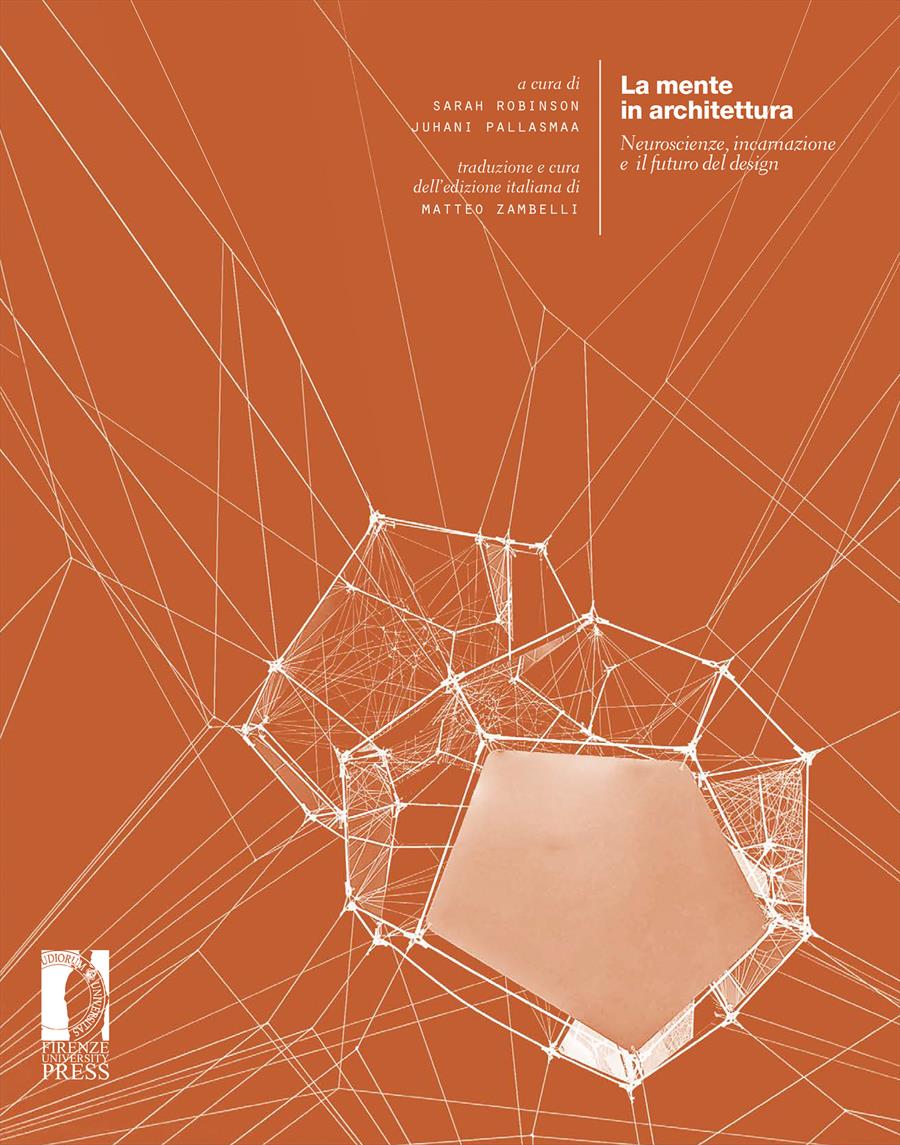- La mente in architettura
- Edited by Sarah Robinson, Juhani Pallasmaa, Matteo Zambelli
Stato d’animo e significato in architettura
- Alberto Pérez-Gómez
- © 2021 Author(s) |
- CC BY-NC-SA 4.0
- DOI: 10.36253/978-88-5518-286-7.13
Explores the role of mood and meaning in architectural experience via the German no-tion of stimmung, relating to the central questions of temperance and harmony in music and architecture. Motor resonance and attunement are under-acknowledged ways that architecture shapes experience. Pedagogical skills that acknowledge the complexity of an embodied and situated consciousness, emphasising qualitative, experiential and em-bodied approaches.
- Keywords:
- Stimmung,
- attunement,
- resonance,
- situated consciousness,
- atmospheres,
McGill University, Canada
- Barrett Louise 2011, Beyond the Brain: How Body and Environment Shape Animal and Human Minds, Princeton University Press, Princeton.
- Crossley Nick 2001, The Social Body: Habit, Identity, Desire, Sage, Londra.
- Damasio Antonio R. 1995, L’errore di Cartesio. Emozione, ragione e cervello umano, Adelphi, Milano,
- Damasio Antonio R. 2004, Alla ricerca di Spinoza: emozioni, sentimenti e cervello, Adelphi, Milano.
- Dillon M.C. 1997, a cura di, Écart et Différence: Merleau-Ponty and Derrida on Seeing and Writing, Humanities Press, Atlantic Highlands, New Jersey.
- Dreyfus Hubert 2012, “Why the Mood in a Room and the Mood of a Room Should Be Important to Architects”, in From the Things Themselves: Architecture and Phenomenology, Kyoto University Press, Kyoto, pp. 23-39.
- Gadamer Hans Georg 1982, La ragione nell’età della scienza, Il melangolo, Genova.
- Gallagher Shaun 2006, How the Body Shapes the Mind, Clarendon Press, Oxford.
- Gusdorf Georges 1982, Fondements du savoir romantique, Payot, Parigi.
- Heidegger Martin 1995, Fundamental Concepts of Metaphysics, Indiana University Press, Bloomington.
- Heller-Roazen Daniel 2013, Il tatto interno: archeologia di una sensazione, Quodlibet, Macerata.
- Kozel Susan 2007, Closer: Performance, Technologies, Phenomenology, The MIT Press, Cambridge, Massachusetts.
- Le Camus de Mézières Nicolas 2005, Lo spirito dell’architettura, o l’analogia di quest’arte con le nostre sensazioni, Il castoro, Milano.
- Merleau-Ponty Maurice 1989, L’occhio e lo spirito, SE, Milano.
- Merlau-Ponty Maurice 2003, “La fenomenologia del linguaggio”, in Segni, Net, Milano.
- Merleau-Ponty Maurice 2004, “Il dubbio di Cézanne”, in Merleau-Ponty Maurice, Senso e non senso, Net, Milano.
- Merleau-Ponty Maurice 2009 , Fenomenologia della percezione, Bompiani, Milano.
- Merlau-Ponty Maurice 2010, La struttura del comportamento, Mimesis Edizioni, Milano-Udine.
- Nietzsche Friedrich 1981, “Sull’utilità e il danno della storia per la nostra vita”, in Considerazioni inattuali, Einaudi, Torino.
- Noë Alva 2004, Action in Perception, The MIT Press, Cambridge, Massachusetts.
- Noë Alva 2010, Perché non siamo il nostro cervello: una teoria radicale della coscienza, Raffaello Cortina Editore, Milano.
- Paz Octavio 1991, L’arco e la lira, Il melangolo, Genova.
- Pérez-Gómez Alberto 1983, Architecture and the Crisis of Modern Science, The MIT Press, Cambridge, Massachusetts.
- Pérez-Gómez Alberto 2016, Attunement: Architectural Meaning after the Crisis of Modern Science, The mit Press, Cambridge, Massachusetts.
- Pérez-Gómez Alberto, Pelletier Louise 1997, Architectural Representation and the Perspective Hinge, The MIT Press, Cambridge, Massachusetts.
- Pérez-Gómez Alberto, Sioli Angeliki 2013, “Drawing with/in and Drawing out. A Redefinition of Architectural Drawing through Edward Casey’s Meditations on Mapping”, in Azucena Cruz-Pierre, Donald A. Landes, a cura di, Exploring the Work of Edward S. Casey. Giving Voice to Place, Memory, and Imagination, Bloomsbury Academic.
- Perrault Claude 1684, Les dix livres d’architecture de Vitruve, Parigi.
- Perrault Claude 1993, Ordonnance for the Five Kinds of Columns after the Method of the Ancients, trad. Di Indra Kagis McEwen dalla prima edizione del 1683.
- Ramachandran Vilayanur S., Blakeslee Sandra 1999, La donna che morì dal ridere e altre storie incredibili sui misteri della mente umana, Mondadori, Milano.
- Scarry Elaine 2001, Dreaming by the Book, Princeton University Press, Princeton.
- Schelling Friedrich W. J. 1995, Lettere filosofiche su dommatismo e criticismo, Laterza, Bari.
- Spitzer Leo 1967, L’armonia del mondo: storia semantica di un’idea, Il Mulino, Bologna.
- Thompson Evan 2007, Mind in Life: Biology, Phenomenology, and the Sciences of the Mind, Harvard University Press, Cambridge, Massachusetts.
- Varela Francisco J., Thompson Evan, Rosch Eleonor 1992, La via di mezzo della conoscenza. Le scienze cognitive alla prova dell’esperienza, Feltrinelli, Milano.
Chapter Information
Chapter Title
Stato d’animo e significato in architettura
Authors
Alberto Pérez-Gómez
Language
Italian
DOI
10.36253/978-88-5518-286-7.13
Peer Reviewed
Publication Year
2021
Copyright Information
© 2021 Author(s)
Content License
Metadata License
Bibliographic Information
Book Title
La mente in architettura
Book Subtitle
Neuroscienze, incarnazione e il futuro del design
Editors
Sarah Robinson, Juhani Pallasmaa, Matteo Zambelli
Peer Reviewed
Number of Pages
240
Publication Year
2021
Copyright Information
© 2021 Firenze University Press
Content License
Metadata License
Publisher Name
Firenze University Press
DOI
10.36253/978-88-5518-286-7
ISBN Print
978-88-5518-285-0
eISBN (pdf)
978-88-5518-286-7
eISBN (xml)
978-88-5518-287-4
Series Title
Ricerche. Architettura, Pianificazione, Paesaggio, Design
Series ISSN
2975-0342
Series E-ISSN
2975-0350
